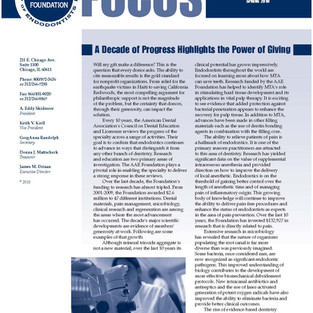In order to develop successful regenerative endodontic therapies, focus must be placed on regeneration of both the pulp and dentin tissues.
While several researchers are working on regenerating the dentin tissue, Dr. Maobin Yang,
a resident at the University of Connecticut, is hoping to be a pioneer in the exploration of angiogenesis—the regeneration of blood vessels in dental pulp.
According to Dr. Yang, the major challenges facing successful pulp angiogenesis are the scaffold design and growth factors. The variations of the root canal morphology limits rigid scaffold placement, and the control over the spatial and temporal distribution of growth factors is extremely tricky. To address these challenges, Dr. Yang has designed a new injectable scaffold. “Once the liquid scaffold is injected, the gelation occurs at the body temperature, utilizing a purely physical phenomenon,” explained Dr. Yang. “In addition, the scaffold is degradable and the rate of degradation can be controlled.”
Preliminary results show that this new scaffold is supporting the proliferation of human mesenchymal stem cells. “These cells are growing very happily,” said Dr. Yang. “Next up, we will test the model using dental pulp stem cells from stem cells from exfoliated deciduous human teeth.”
Dr. Yang is hopeful about the future of regenerative endodontics and its implications for the specialty. “Regenerative endodontics is a new direction,” he said. “We have a long way to go but hopefully in the future we will be able to provide new treatment venues.”
When not creating innovative scaffold platforms,
Dr. Yang spends time watching sports and reading with his wife. Originally from Chengdu, China, he received his dental degree from West China College of Stomatology. He completed his five-year Ph.D. program in skeletal, craniofacial and oral biology at the University of Connecticut in the spring of 2009 and is expected to receive his Certificate in Endodontics in 2012.




Comments